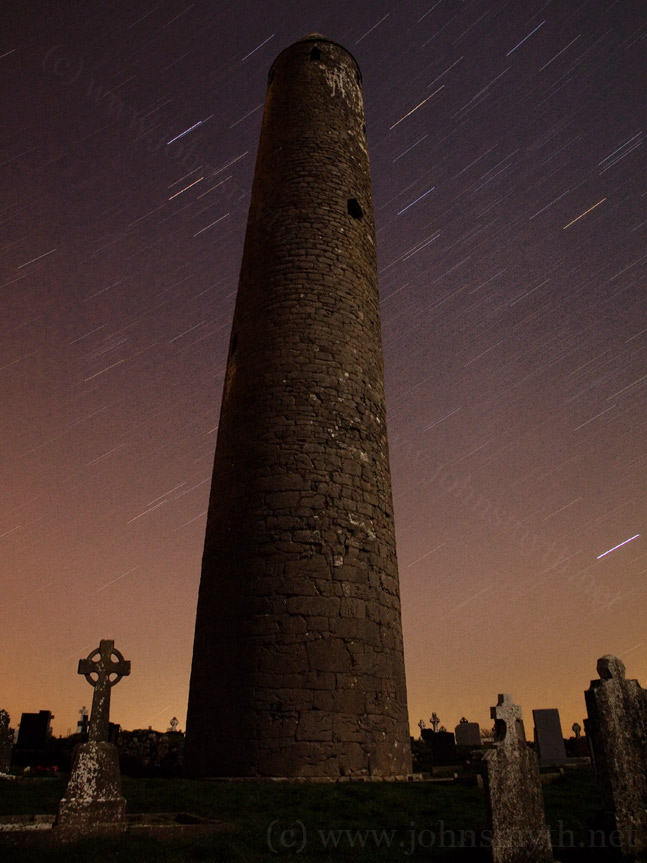February 25, 2008
The Stars of Orion

Bright trails of the stars of Orion form a background to a long-exposure image of the Round Tower at Kilmacduagh, which is also illuminated by moonlight. Taken on the same night as the fly-past of the ISS & Space Shuttle. The round Tower at Kilmacduagh is the tallest in Ireland and leans over by a metre from the vertical.
Camera=5D,lens=24-105@24mm,aperture=f9, speed=921sec (15mins, 21 secs)**,ISO=640.
The constellation of Orion has hung in the night sky for the entirety of human history. A coincidence of cosmic alignment has caused the stars to appear, from the vantage point of Earth, as if in formation. They first appeared as they appear now around 1.5 million years ago, around the time as an early ape-man, Homo Erectus, began to figure out how to use tools and fire. The constellation is a human invention - from other points in space, the constellation does not exist, because the stars are quite a distance apart from each other.
The stars of Orion, particularly the three bright stars in a row known as the Belt of Orion [Zeta, Epsilon and Delta Orionis] feature in almost every culture in recorded history - one of the markers of human accomplishment in any early society was the study of astronomy, and Orion is one of the most noticeable and easiest to find in the sky.
A beam of light pictured in the star trails above left the constellation around 900 years ago, around the time that the round tower at Kilmacduagh was built. It was half way through its journey when Galileo developed the first telescope and opened up the unseen heavens for observation. I took the picture last week, and when I got up that morning, that beam of light was passing through the heliosphere - that boundary where the cosmic rays of the Sun (the Solar Wind) clashes with the force of the Interstellar Medium - the cosmic rays that pervade the universe*. Shortly afterwards, that beam of light would be as close as the furthest point at which humanity has succeeded in flinging an object [Voyager 1, launched in 1977 and now roughly 9.8 billion miles from our Solar System*].
The image above took about a quarter of an hour to expose**, and in that time, that beam of light travelled from beyond Mars, through the atmosphere and struck the camera sensor just in time to make the image. Well, a whole bunch of light rays hit the sensor, really - otherwise, it wouldn't be much of a background.
As you are reading this, light is leaving the Orion constellation that will reach Earth in the early 2900s. I wonder if Kilmacduagh's tower will still point to the night sky. And I wonder, of all the buildings erected in Ireland during the last fifteen, free-spending years, will any of them still stand to reflect Orion's light?
* Voyager I will soon be the first man-made object to encounter the heliosphere.
** The Canon 5D was set to perform in-camera noise-reduction, which means that, after the first exposure, it took a second one of the same duration to help cancel out some of the noise (i.e. fuzzy bits in the background) in the image. The total duration was therefore nearly 31 minutes.
See all images in the Kilmacduagh series.
kilmacduagh, gort, monastic, site, monastery, round, tower, ireland, star, trail,long, exposure, night, nocturne, ireland, irishblogs, photoblogs, photography, photographs, pictures, galwayblogs, blog, monasset, north atlantic skyline, john smyth, Canon, 5D, february, 2008
Posted by monasset at February 25, 2008 09:35 PM